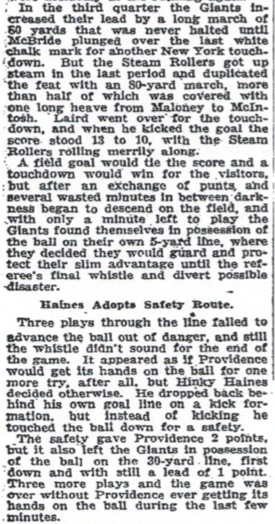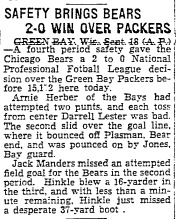How often are safeties — the two-point kind — a major topic of conversation on an NFL Sunday (or even a minor topic of conversation)? They factored mightily, though, in two Week 5 games. In fact, both came in the fourth quarter and put teams in position for comeback wins, one of them in overtime. Safeties don’t get much more momentous than that.
The Browns scored the first with 11:02 left when linebacker Tank Carder swooped in and blocked a punt by the Titans’ Brett Kern out of the end zone. That narrowed the Tennessee lead to 28-15. Two Brian Hoyer-to-Travis Benjamin touchdown passes followed, giving the Cleveland — which had once trailed 28-3 — a stunning 29-28 victory. (As an added bonus, it was the biggest comeback in franchise history and the biggest road comeback in NFL/AFL history.)
And just think: It might never have happened without Carder’s safety.
A little later, at the Superdome, the Saints were down 31-26 to the Bucs with 6:44 to go in regulation when linebacker Junior Galette sacked Mike Glennon in the end zone to make it a three-point game. Shayne Graham booted a 44-yard field goal to send it to OT tied at 31, and New Orleans’ Khiry Robinson ended it by running 18 yards for the deciding score.
You’ve gotta admit, few things in football are more scintillating than a timely safety.
The only way the day could have been better is if one of the safeties had come in overtime. We’ve only had three of those, the most recent by the Dolphins’ Cameron Wake last season vs. the Bengals. Details here, courtesy of the Pro Football Hall of Fame website.
Safeties are kind of like a two-dollar bill. They change the arithmetic of a game. Granted, the two-point conversion also changes the math, but not nearly as dramatically. The latter, after all, gives a club only one additional point; it would have kicked the PAT, which is virtually automatic, anyway. Also, after a successful two-point conversion, you have to kick the ball away (unless, of course, you want to risk an onside kick). After a safety, you get to retain possession. The other team has to kick the ball to you. (Plus, it puts That Crazy Look in the eyes of your defense, which should never be underestimated.)
Funny thing is, when the NFL was getting going in the ’20s, the safety rule was much different. The play was still worth two points, but the team that gave up the safety, strangely enough, got to keep the ball. It was given a new set of downs starting from its 30.
The rule was changed in 1926 because clubs – pro and college both – were abusing it. If they were backed up in their own end late in the game and ahead by three or more, they’d take an intentional safety and run three more clock-killing plays. And if they were still comfortably ahead at that point, they could take another intentional safety and run three more plays. It was ridiculous. If you had a big enough lead, you could — theoretically, at least — keep taking intentional safeties and eat up the last several minutes of a game without having to lose possession.
Check out this excerpt from a New York Times story in 1925. It talks about the Giants, leading the Providence Steam Roller by a field goal in the closing minutes, pulling just such a stunt.
That “Hinky” Haines was a crafty one. (I put Hinky in quotes because his nickname was usually spelled H-i-n-k-e-y.)
You might also get a kick out of this excerpt from a Chicago Tribune story on the Racine (Wis.) Legion’s 10-4 win over the Chicago Cardinals in 1923. It’s the only time in NFL history a team has scored four points in a game. (And the Cards had Racine quarterback Shorty Barr to thank for it.)
Even after the rewrite in 1926, the safety rule needed some tweaking. That was evident after the Redskins lost the 1945 championship game to the Cleveland Rams, 15-14, because Sammy Baugh threw a pass out of his end zone that struck one of the goal posts — which in those days were located on the goal line. (It was considered a safety, for some forgotten reason, if the ball landed in the end zone.)
You can see the play — sort of — in this brief clip. (It was a miserably cold day. Players huddled under straw on the sideline to keep from getting frostbite.)
Naturally, Washington owner George Preston Marshall lobbied at the next league meeting to amend the antiquated — and rarely enforced — rule. And his lodge brothers went along because, well, an incomplete pass is an incomplete pass, right? Why should it ever be a safety? (Unless, that is, the quarterback throwing out of the end zone is guilty of intentional grounding. See Tom Brady in Super Bowl XLVI.)
After that, the safety receded into history and became what it always should have been: a curiosity, a freak occurrence, a mint left on a defender’s pillow. There hasn’t been a 2-0 final score since 1938, the Bears edging the Packers, and the safety certainly hasn’t had many memorable moments over the decades.
The biggest safety I can think of in recent years is the one that helped the Titans break open the 1999 AFC title game against the Jaguars. Tennessee was up 17-14 midway through the third quarter when defensive tackles Josh Evans and Jason Fisk broke through and sacked Mark Brunell in the end zone. Then Derrick Mason returned the free kick 80 yards for a touchdown, and the Titans were on their way to their first and only Super Bowl. A screen shot of the play-by-play:
One last factoid before you go: In 1929, when the Packers won their first NFL championship, they went undefeated (12-0-1) and outscored their opponents 198-22. At home, their defense was practically unscored on. In five games, they gave up only four points. Two safeties.




